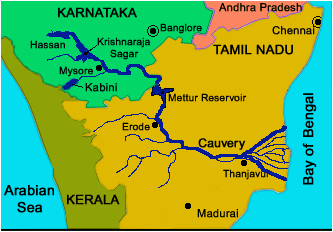Mekedatu Project | 05 Jun 2023
For Prelims: Mekedatu project, Cauvery and its tributary Arkavathi, Cauvery Water Disputes Tribunal, National Board for Wildlife (NBWL), Central Water Commission (CWC)
For Mains: Interstate water disputes, Diplomacy in resolving interstate water disputes, Water governance
Why in News?
The Karnataka Assembly has unanimously adopted a resolution requesting clearance for the Mekedatu drinking water and balancing reservoir project.
- This resolution was in response to Tamil Nadu's opposition to the project.
What is Mekedatu Project?
- About:
- The Mekedatu project is a multipurpose project involving the construction of a balancing reservoir near Kanakapura in Ramanagara district, Karnataka.
- Mekedatu, meaning goat’s leap, is a deep gorge situated at the confluence of the rivers Cauvery and its tributary Arkavathi.
- Its primary objectives are to provide drinking water to Bengaluru and neighboring areas, totaling 4.75 TMC, and generate 400 MW of power.
- Benefits of the Project:
- Meeting the growing demand for drinking water in Bengaluru and its adjoining areas facing water scarcity and dependence on groundwater.
- Harnessing renewable energy by generating 400 MW of hydroelectric power.
- Contributing to renewable energy production and reducing carbon emissions.
- Regulating the flow of water to prevent floods and droughts, benefiting farmers and communities.
- Current Status:
- Karnataka has not obtained the consent of Tamil Nadu, which is mandatory.
- The project is still in its preliminary stage and has not obtained the necessary clearances and approvals from authorities such as the Central Water Commission (CWC), the Ministry of Environment, Forest and Climate Change (MoEFCC), and the National Board for Wildlife (NBWL).
- Opposition By Tamil Nadu:
- Tamil Nadu argues that the Mekadatu dam would significantly reduce the water flow downstream, negatively impacting the state's agricultural activities and water supply.
- The Cauvery River is a crucial water source for Tamil Nadu, supporting its farming communities and meeting the drinking water needs of its residents.
- The state claims that the project violates the final judgment of the Cauvery Water Disputes Tribunal (CWDT), which allocated a specific share of water to each riparian state, including Tamil Nadu.
What is the Cauvery River Dispute?
- River Cauvery (Kaveri):
- It is known as ‘Ponni’ in Tamil, and it is the fourth largest river in southern India.
- It is a sacred river of southern India. It rises on Brahmagiri Hill of the Western Ghats in southwestern Karnataka state, flows in a southeasterly direction through the states of Karnataka and Tamil Nadu, and descends the Eastern Ghats in a series of great falls and drains into Bay of Bengal through Pondicherry.
- Left Bank Tributary: Arkavathi, Hemavathi, Shimsa, and Harangi.
- Right Bank Tributary: Lakshmantirtha, Suvarnavati, Noyil, Bhavani, Kabini, and Amaravathi.
- The Dispute:
- Historical Background:
- As the river originates in Karnataka, flows through Tamil Nadu with major tributaries coming from Kerala and drains into the Bay of Bengal through Pondicherry the dispute therefore involves 3 states and one Union Territory.
- The genesis of the dispute is 150 years old and dates back to the two agreements of arbitration in 1892 and 1924 between the then Madras presidency and Mysore.
- It entailed the principle that the upper riparian state must obtain consent of lower riparian state for any construction activity viz. reservoir on the river Cauvery.
- The Cauvery water dispute between Karnataka and Tamil Nadu began in 1974 when Karnataka started diverting water without Tamil Nadu's consent.
- After several years, the Cauvery Water Disputes Tribunal (CWDT) was established in 1990 to resolve the issue. It took 17 years for the CWDT to reach a final order in 2007, which outlined the sharing of Cauvery water among the four riparian states. In distress years, water would be shared on a pro-rata basis.
- In 2018, the Supreme Court declared the Cauvery a national asset and largely upheld the water-sharing arrangements determined by the CWDT.
- It also directed the Centre to notify the Cauvery Management Scheme. The central government notified the ‘Cauvery Water Management Scheme’ in June 2018, constituting the ‘Cauvery Water Management Authority’ and the ‘Cauvery Water Regulation Committee’.
- Historical Background:
Way Forward
- Joint River Rejuvenation:
- Launch a collaborative initiative to restore the entire Cauvery River, addressing pollution and habitat degradation.
- Eco-friendly Design:
- Redesign the Mekedattu project with eco-friendly features and minimal environmental impact.
- Explore innovative engineering solutions, to ensure minimal disruption to the river's natural flow and the surrounding ecosystem.
- Redesign the Mekedattu project with eco-friendly features and minimal environmental impact.
- Cultural Exchange:
- Organize cultural events that celebrate the shared cultural heritage and traditions of both Karnataka and Tamil Nadu. This fosters a sense of unity and mutual respect, helping to strengthen the bond between the states and create a conducive atmosphere for resolving dispute.
- Real-time Monitoring and Data Sharing:
- Implement a robust system for real-time monitoring of water levels, rainfall patterns, and river flows. This data should be shared transparently between the states to enable informed decision-making and foster trust.
UPSC Civil Services Examination, Previous Year Question (PYQ)
Prelims
Q. Which of the following Protected Areas are located in Cauvery basin? (2020)
- Nagarhole National Park
- Papikonda National Park
- Sathyamangalam Tiger Reserve
- Wayanad Wildlife Sanctuary
Select the correct answer using the code given below:
(a) 1 and 2 only
(b) 3 and 4 only
(c) 1, 3 and 4 only
(d) 1, 2, 3 and 4
Ans: (c)
Mains
Q. Constitutional mechanisms to resolve the inter-state water disputes have failed to address and solve the problems. Is the failure due to structural or process inadequacy or both? Discuss. (2013)


